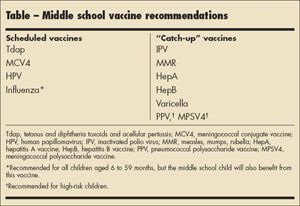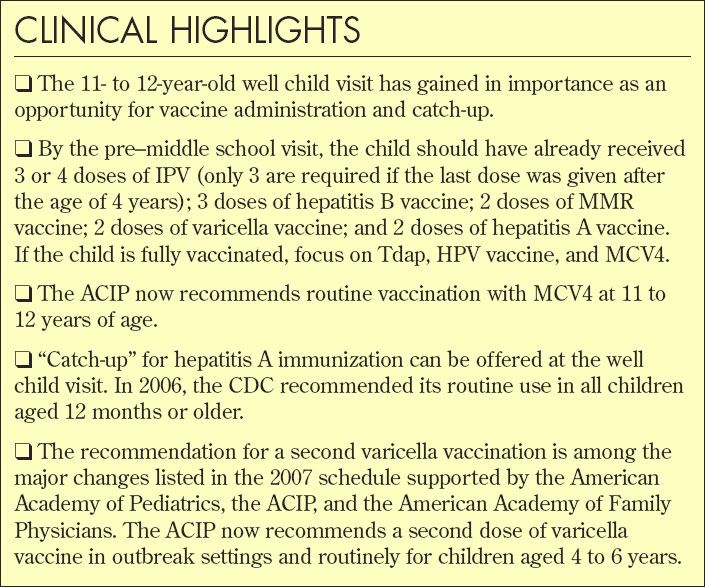Middle School: A Time for Maturation-and Vaccination
ABSTRACT: The pre-middle school well child visit is now an important landmark on the vaccine schedule. The pre-kindergarten visit no longer has the distinction of being the last of the visits for "school shots." Pediatricians should emphasize this point at the 4- to 6-year-old well child visit so that parents are aware of the need for another series of vaccines in about 5 years.
The middle school child (and parents!) can be overwhelmed by physical and social maturational changes during this time. Parents should not have to also worry about their child's susceptibility to vaccine-preventable diseases.
The 11- to 12-year-old well child visit has become an important opportunity for vaccine administration and catch-up. Several studies have shown that middle school vaccine requirements are associated with high levels of older children receiving vaccinations against such pathogens as hepatitis B, varicella, and tetanus.1-5
Here the newest recommendations for the immunization of the middle school child are described.
RECOMMENDED VACCINES

By the pre-middle school visit, the child should have already received 3 or 4 doses of IPV (inactivated polio vaccine) (only 3 are required if the last dose was given after the age of 4 years); 3 doses of hepatitis B vaccine; 2 doses of MMR vaccine (measles, mumps, rubella); 2 doses of varicella vaccine; and 2 doses of hepatitis A vaccine. If the child is fully vaccinated up to this point, the 3 vaccines to focus on are Tdap (tetanus and diphtheria toxoids and acellular pertussis), human papillomavirus (HPV) vaccine, and MCV4 (meningococcal conjugate vaccine) (Table).
Tetanus and pertussis. The recommendation to boost tetanus and pertussis immunity with the Tdap vaccine at this time is sensible because adolescents and adults are considered sources of pertussis infection for the younger child.6 A review by Middleman7 of pertussis immunization emphasizes that immunity from vaccination can start to wane after 5 years which, for most, will be around the time of entry into middle school. Two Tdap vaccines (Adacel and Boostrix) approved for middle school-aged children are available in the United States and should be given in place of the usual Td (tetanus and diphtheria toxoid) booster. An interval of at least 5 years between Td and Tdap is ideal, but an interval as short as 2 years is probably safe.8
HPV infection. Approved only for girls, the HPV vaccine is recommended for administration in 3-dose series (0, 2, then 6 months) beginning at age 11 years. The vaccine can be given as early as age 9 years--ideally before sexual activity commences.
Dunne and colleagues9 reported that more than one quarter of girls aged 14 to 24 years who participated in the 2003-2004 National Health and Nutrition Examination Survey were found to be HPV-positive. Another study of 162 girls aged 12 to 15 years found that 24% had already engaged in genital contact and 6% had already engaged in sexual intercourse.10 These percentages increased significantly to 44% and 19%, respectively, when girls were surveyed 1 year later.
Another recent study found that 44% of more than 600 adolescents aged 14 years at study entry had already engaged in oral and/or vaginal sex.11 Although consistent use of condoms can reduce the risk of cervical and vulvovaginal HPV infection,12 it is known that adolescents are not the most consistent users. Engaging in early intercourse (by age 14) has been shown to be a predictor of lack of contraceptive use.13
Relying on safe sex practices alone will not stop the spread of HPV.
The currently available vaccine (Gardasil) is highly effective against 4 types of HPV (types 6, 11, 16, 18).14 Types 6 and 11 are responsible for the vast majority of genital warts, and types 16 and 18 cause the majority of cervical cancers. Whether this vaccine should be mandated for school entry is presently a matter of debate, as is its cost-effectiveness.15 Many states are introducing legislation, while some states (ie, Texas and New Mexico) have already passed legislation that requires HPV vaccination of sixth-grade girls.16
A second vaccine against HPV infection (Cervarix, GlaxoSmithKline) is currently undergoing clinical trials to determine its efficacy and safety in protecting against cervical cancer. The vaccine targets HPV types 16 and 18.17
Girls and women are presently the only targeted groups, but HPV does not discriminate based on the patient's gender. Laurikka and associates18 reported that 22 male partners of 45 women with confirmed genital HPV were also infected with HPV, although only 7 had obvious condylomatous penile lesions. Recent evidence has also shown that oral HPV infection is strongly associated with oropharyngeal cancer.19 Although males are an important part of the equation, there is no recommendation yet for their vaccination.
Meningococcal infection. The Advisory Committee on Immunization Practices (ACIP) of the CDC20 now recommends routine vaccination with MCV4 (meningococcal conjugate vaccine [Menactra]) at 11 to 12 years of age. A 2005 AAP policy statement has set a goal of having all adolescents immunized with MCV4 at age 11 years by the year 2008. Approved for age 11 years or older, MCV4 is administered intramuscularly, as opposed to MPSV4 (a meningococcal polysaccharide vaccine, Menomune) which is approved for age 2 years or older and administered subcutaneously.21
CATCH-UP VACCINES
The well child visit before entry into middle school also allows for administration of any catch-up vaccines. It would be highly unusual for an 11-year-old not to have completed IPV, MMR, and perhaps hepatitis B vaccinations if he or she is already attending public school. If vaccination is deficient, however, the child should be immunized accordingly. Only 3 doses of IPV, each given 4 weeks apart, are recommended for the unvaccinated child 7 to 18 years old. Likewise, 2 doses of MMR, given 4 weeks apart, will "catch up" the insufficiently vaccinated middle school child.
Hepatitis B vaccination. Keep in mind that hepatitis B is a sexually transmitted disease and that pre- exposure vaccination is effective at preventing transmission. The hepatitis B immunization schedule is highly flexible and the series of injections should not be restarted even if a long lag time exists between doses. Administer the necessary doses as soon as the deficiency is realized.
Hepatitis A and varicella vaccination. In 2007, insufficient vaccination against hepatitis A and varicella is still the norm in 11- to 12-year-olds because recommendations for the timing of the administration of these 2 vaccines are so new. Catch-up vaccine for hepatitis A can be offered at the well child visit since, in 2006, the CDC recommended its routine use in all children aged 12 months or older.22 As with the hepatitis B vaccine, the hepatitis A series should not be restarted if there is a large gap between doses; only the required vaccines need to be administered to complete the series.22
The recommendation for a second varicella vaccination is one of the major changes listed in the 2007 schedule supported by the AAP, ACIP, and the American Academy of Family Physicians.23 The ACIP now recommends a second dose of varicella vaccine in outbreak settings and routinely for children aged 4 to 6 years. If the second dose was not given at the pre-kindergarten visit, the second dose can be administered now; a child who has never received varicella vaccine needs 2 doses, 4 weeks apart, to complete vaccination. Marin and colleagues24 emphasize that catch-up vaccination with varicella vaccine for the older child is crucial to eliminate susceptibility in this group who is at greater risk for more severe disease with natural infection.

Pneumococcal disease and influenza vaccination. It is especially important to ensure that children with underlying illness are given hepatitis A vaccine as well as PPV (pneumococcal polysaccharide vaccine) and influenza vaccine. PPV is important for those patients with asplenia or terminal complement deficiency, and patients with chronic liver disease would benefit from hepatitis A vaccination. Yearly influenza vaccine is now recommended for all children aged 6 to 59 months, but the otherwise healthy older child will also benefit from this vaccine.
If the child did not receive the recommended number of doses of HIB (Haemophilus influenzae type b conjugate) vaccine or PCV (pneumococcal conjugate vaccine), no further action is needed since neither one is routinely administered after the age of 5 years. *
REFERENCES:1. Averhoff F, Linton L, Peddecord KM, et al. A middle school immunization law rapidly and substantially increases immunization coverage among adolescents. Am J Public Health. 2004;94:978-984.
2. Fogarty KJ, Massoudi MS, Gallo W, et al. Vaccine coverage levels after implementation of a middle school vaccination requirement, Florida, 1997-2000. Public Health Rep. 2004;119:163-169.
3. Jacobs RJ, Myerhoff AS. Effect of middle school entry requirements on hepatitis B vaccination coverage. J Adolesc Health. 2004;34:420-423.
4. Rickert D, Deladisma A, Yusuf H, et al. Adolescent immunizations. Are we ready for a new wave? Am J Prev Med. 2004;26:22-28.
5. Wilson TR, Fishbein DB, Ellis PA, et al. Theimpact of a school entry law on adolescent immunization rates. J Adoles Health. 2005;37:511-516.
6. American Academy of Pediatrics Committee on Infectious Diseases. Prevention of pertussis among adolescents: recommendations for use of tetanus toxoid, reduced diphtheria toxoid, and acellular pertussis (Tdap) vaccine. Pediatrics. 2006;117:965-978.
7. Middleman AB. Immunization update: pertussis, meningococcus, and human papillomavirus. Adolesc Med Clin. 2006;17:547-563.
8. Broder KR, Cortese MM, Iskander JK, et al; Advisory Committee on Immunization. Practices(ACIP). Preventing tetanus, diphtheria and pertussis among adolescents: use of tetanus toxoid, reduced diphtheria toxoid and acellular pertussis vaccines recommendations of the Advisory Committee on Immunization Practices (ACIP). MMWR. 2006;55(RR-3):1-34.
9. Dunne EF, Unger ER, Sternberg M, et al. Prevalence of HPV infection among females in the US. JAMA. 2007;297:813-819.
10. O'Sullivan LF, Brooks-Gunn J. The timing of changes in girls' sexual cognitions and behaviors in early adolescense: a prospective, cohort study. J Adolesc Health. 2005;37:211-219.
11. Brady SS, Halpern-Felsher BL. Adolescents' reported consequences of having oral sex versus vaginal sex. Pediatrics. 2007;119:229-236.
12. Winer RL, Hughes JP, Feng Q, et al. Condom use and the risk of genital human papillomavirus infection in young women. N Engl J Med. 2006; 354:2645-2654.
13. Magnusson C, Trost K. Girls experiencing sexual intercourse early: could it play a part in re-productive health in middle adulthood? J Psychosom Obstet Gynaecol. 2006;27:237-244.
14. Nicoletti A. Cervical cancer vaccine. J Pediatr Adolesc Gynecol. 2006;19:423-424.
15. Weller SC, Stanberry LR. Estimating the population prevalence of HPV. JAMA. 2007;297:876-878.
16. Riley L. Follow-up data show HPV vaccine efficacy remains high. Infect Dis Children. 2007;20:29, 32.
17.Cervarix. GlaxoSmithKline Web site. Available at: http://www.gsk.com/media/press-kits/cervarix-clinical-trials.pdf. Accessed August 8, 2007.
18. Laurikka J, Ala-Opas M, Kivinen S. Genital human papillomavirus infections in the male sexual partners of 45 female patients with papillomavirus infection. Ann Chir Gynaecol. 1990;79:54-57.
19. D'Souza G, Kreimer AR, Viscidi R, et al. Case-control study of human papillomavirus and oropharyngeal cancer. N Engl J Med. 2007;356:1944-1956.
20. Centers for Disease Control and Prevention. Prevention of Hepatitis A through active or passive immunizations: recommendations of the Advisory Committee on Immunization Practices (ACIP). MMWR. 2006;55(RR-7):1-23.
21.American Academy of Pediatrics Committee on Infectious Diseases. Prevention and control of meningococcal disease: recommendations for use of meningococcal vaccines in pediatric patients. Pediatrics. 2005;116:496-505.
22. Williams JL, Bruden DA, Cagle HH, et al. Hepatitis A vaccine: immunogenicity following administration of a delayed immunization schedule in infants, children and adults. Vaccine. 2003;21:3208-3211.
23. Centers for Disease Control and Prevention. Recommendations and Guidelines: 2007 Child & Adolescent Immunization Schedules. Available at: http://www.cdc.gov/vaccines/recs/schedules/child-schedule.htm. Accessed July 30, 2007.
24. Marin M, Nguyen HQ, Keen J, et al. Importance of catch-up vaccination: experience from a varicella outbreak, Maine, 2002-2003. Pediatrics. 2005;115:900-905.
Newsletter
Access practical, evidence-based guidance to support better care for our youngest patients. Join our email list for the latest clinical updates.